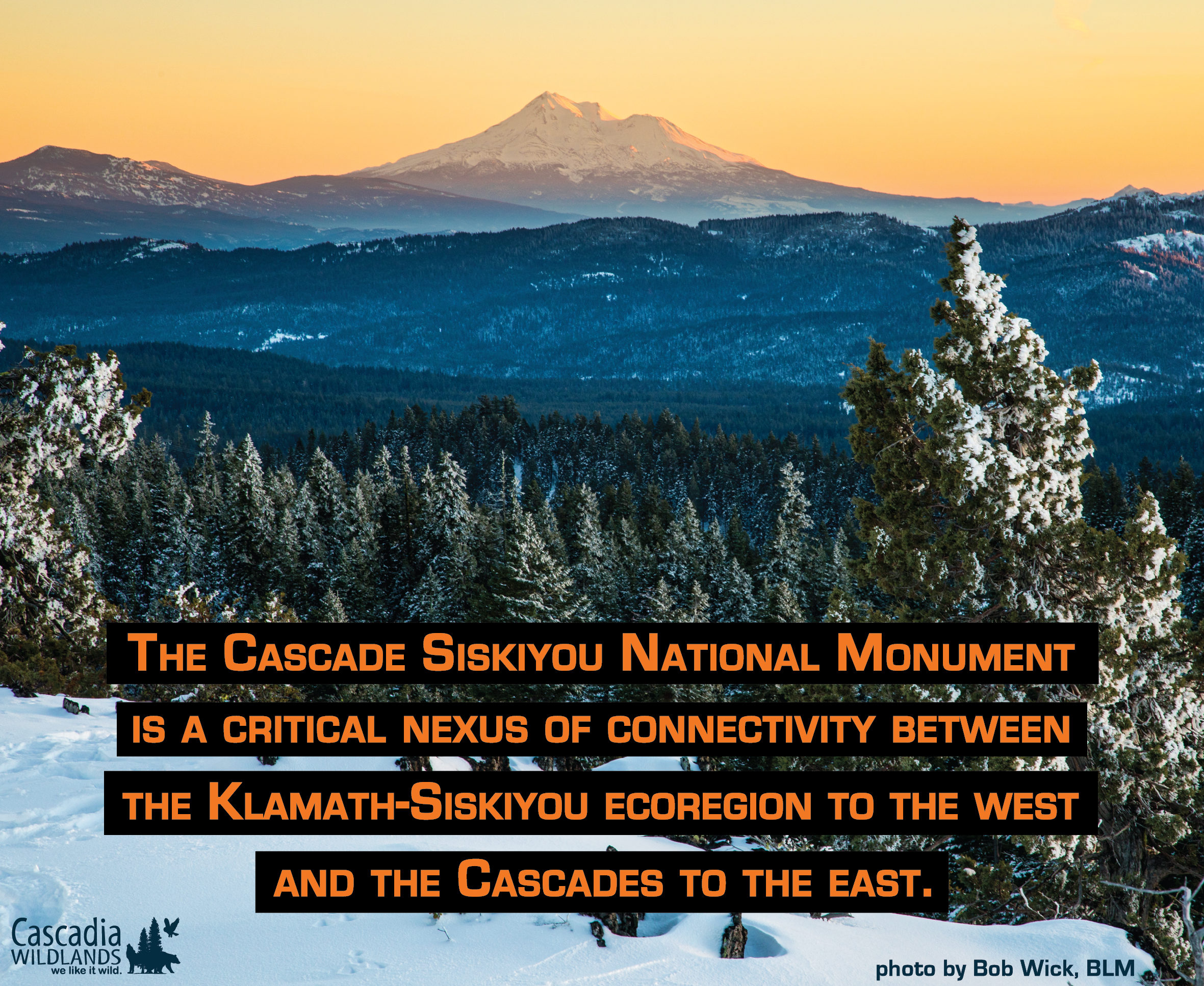by Sam Krop, Cascadia Wildlands Grassroots Organizer
 Straddling the border of Oregon and California, the beautiful and biologically unique Cascade-Siskiyou National Monument has received a lot of public attention lately. According to the Monument’s June 2000 establishing proclamation, the land is worthy of protection under the Antiquities Act as an “ecological wonder,” and a unique “biological crossroads” where several distinct ecoregions collide. In January of 2017, the Obama administration approved expanding the Monument by 42,000 acres in Oregon and adding 5,000 acres in California. Now, following hasty and ill-informed recommendations from Secretary of the Interior, Ryan Zinke, the Monument is under threat of being stripped of those protections by the Trump administration.
Straddling the border of Oregon and California, the beautiful and biologically unique Cascade-Siskiyou National Monument has received a lot of public attention lately. According to the Monument’s June 2000 establishing proclamation, the land is worthy of protection under the Antiquities Act as an “ecological wonder,” and a unique “biological crossroads” where several distinct ecoregions collide. In January of 2017, the Obama administration approved expanding the Monument by 42,000 acres in Oregon and adding 5,000 acres in California. Now, following hasty and ill-informed recommendations from Secretary of the Interior, Ryan Zinke, the Monument is under threat of being stripped of those protections by the Trump administration.
This is a simple telling of the Cascade-Siskiyou’s history, and it doesn’t take a lot of digging to learn that there is lot more to the story than what appears on the surface. To really comprehend the extraordinary nature of this place, you have to visit it yourself. For this reason, my partner and I took a trip down to the Monument—to see what we could learn from the place itself.
We dedicated the first part of our journey to exploring the land within the 2016 expanded boundary. In a single day’s journey, we walked through sprawling oak savannah, high desert-like country rich with sage, and mature forests boasting massive fir and pine. We saw a post-fire ecosystem in resurgence, ook in the breathtaking views of Shasta to the south and Mount McLoughlin to the north from rocky crags and heard the trickling of water making its way through crevices underground. We walked the same trail that Zinke walked during his official Monument “review,” but I could not help but feel that we and Zinke were seeing completely different things.
From our exploration, it was immediately evident that the land granted protection with the Monument’s expanded boundaries is far more than what Secretary Zinke called a “buffer” for the biological diversity inside of the original boundary. On the contrary, according to a 2011 study published by a diverse group of scientists, the expansion area is described as a part of, and home to many of the important ecological features the Monument was originally intended to protect. The scientists go on to argue that “without Monument expansion…some of the area’s important biological values were at high risk of degradation and loss.” The words of these scientists reflect what we saw when we visited—that far from being a buffer, the land inside of the recent Monument expansion is an integral part of this incredible ecological wonderland.
In addition to seeing breathtaking natural wonders, in our journey within the newly protected Monument expansion area, we saw hundreds of cattle, miles of fencing and forests in recovery from commercial logging. Here again, our experience was different than Zinke’s. While we saw a place that is healing and in need of continued protection in order to fully recover, Zinke saw a lost opportunity for more commercial activity. In fact, Zinke’s driving criticism of the Monument is that Monument protections do not well-serve commercial logging and grazing interests. Indeed, according to its establishing proclamation, the purpose of the Monument is to protect the “biological crossroads,” and the “spectacular variety of rare and beautiful species of plants and animals,” not to serve commercial interests.
Zinke’s assertion that we can somehow increase commercial activity and simultaneously protect biodiversity is ill-informed at best and intentionally misleading at worst. The known destructive impacts of commercial logging on biologically sensitive areas are the exact reason why lands in the Cascade-Siskiyou Monument are protected from timber companies. In addition, while there are still numerous commercial grazing allotments in the Monument expansion area, we also know that commercial grazing negatively impacts biological integrity. The findings of a 2008 Bureau of Land Management study decisively illustrate this point. The study, completed over the course of many years and using several key biological indicators, found that the proliferation of commercial grazing has created measurable adverse impacts to the native species and natural features of the Monument.
In sum, we know that commercial logging and grazing are not compatible with protecting sensitive ecological areas. What Zinke does not seem to grasp is that you cannot simultaneously claim to protect a place and promote the very activities which have been shown to threaten it.
In a time when biodiversity is collapsing at an unprecedented rate, the Cascade-Siskiyou is so incredibly precious. At root here is a simple question: Do we value biological integrity in a special place like this enough to truly protect it? Thousands of Oregonians, including Oregon’s Governor and both of Oregon’s U.S. Senators, continue to answer that question with a resounding ‘yes.’ As he considers Zinke’s recommendations to shrink Cascade-Siskiyou and make it a “protected area” in name only, it remains to be seen whether Trump will respect Oregon’s top statewide elected leaders – and this very special place – or not.
For more information about how to get involved to save the Cascade Siskiyou National Monument, sign up for our e -news or visit Monuments for All.
